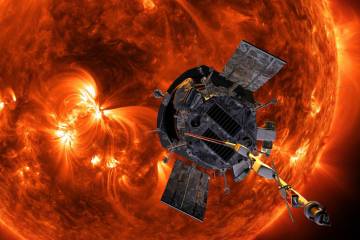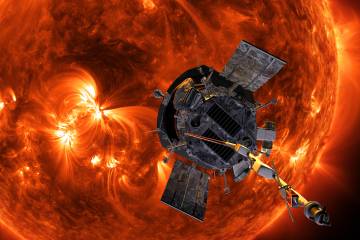- Name
- Geoffrey Brown
- Geoffrey.Brown@jhuapl.edu
- Office phone
- 240-228-5618
What's got a group of engineers and scientists on the edges of their seats today? The Parker Solar Probe's closest approach to the sun yet.
Think of it as the spacecraft's trial by fire—almost literally.
At 10:28 p.m. tonight, the Parker Solar Probe will achieve its first perihelion, the point on its orbit when it is closest to the sun. Flying through material that reaches as high as 3.6 million degrees Fahrenheit, the spacecraft will travel within 15 million miles of the sun's surface and reach a top speed of 213,200 miles per hour.
How did the Parker Solar Probe's journey of 90 million miles begin?
During the perihelion and for some time afterwards, the Parker Solar Probe will be completely out of contact with the mission operations team back at the Johns Hopkins Applied Physics Laboratory because of interference from the sun's overwhelming radio emissions. Scientists will anxiously await a beacon tone from the spacecraft, which will let them know the status of the probe.
During its orbit, the spacecraft will be protected from solar radiation by the Thermal Protection System, or heat shield. Designed by engineers at APL and at the Whiting School of Engineering, the heat shield is composed of carbon-carbon sheets surrounding about 4.5 inches of carbon foam and topped with a ceramic coating of bright white aluminum oxide to reflect the sun's heat and light. The sun-facing side of the heat shield will be exposed to temperatures as high at 2,500 degree Fahrenheit, while the back of the shield will reach only 600 degrees.
A host of autonomous systems will keep the spacecraft safe without guidance from mission operations during its orbit—including automatic retraction of the solar panels to regulate their temperature, sensors that help the spacecraft maintain its orientation in orbit to keep the instruments in the heat shield's shadow, and a sophisticated guidance and control system that keeps the spacecraft pointed correctly.
"You can't do Parker Solar Probe unless you're willing to build an autonomous spacecraft that can take care of itself ... and all these [systems] contain some level of risk," says Andrew Driesman, project manager for Parker Solar Probe. "We're going to go closer to the sun than any other spacecraft has gone before, and we're not going to do that once, we're not going to that twice, we're going to do that 24 times. And that is terrifying."
Posted in Science+Technology
Tagged applied physics laboratory, nasa, outer space, parker solar probe










